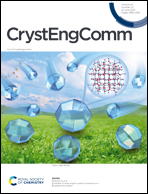Structural stability and initial decomposition mechanisms of BTF crystals induced by vacancy defects: a computational study†
Abstract
Density functional tight binding (DFTB) and DFTB-based molecular dynamics (DFTB-MD) were used to study the effects of vacancy defects on the structure, stability, and initial decomposition mechanisms of condensed phase benzotrifuroxan (BTF). It is found that the vacancies tend to be distributed in the form of aggregation in thermodynamics. The DFTB-MD simulations show that the initial decomposition path of the BTF molecule does not change when vacancies are introduced into the BTF crystal. The opening of the furoxan ring by the N–O bond fracture is the most important decomposition path of BTF. Moreover, the BTF molecules around the vacancy defects are easier to decompose. CNO and NO are important intermediates in the decomposition of BTF. The diffusion coefficients of the C, N, and O atoms in the vacancy-containing systems are greater than those in the ideal system. Among these atoms, the vacancies have the greatest influence on the diffusion of the C atoms. Our results may be helpful to reveal the effects of vacancy defects on the structural stability and initial decomposition mechanisms of energetic crystals.



 Please wait while we load your content...
Please wait while we load your content...